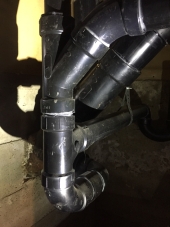Hi Francien,
Sounds like you have the perfect site for a gravity flow greywater system!
And it sounds like a simple type of greywater system would be a good match for your home/landscape.
With a simple greywater system the only filter you need will be in the landscape. You'll create what are called "mulch basins," shallow depressions in the soil that are filled with wood chips, this is where you'll direct greywater to be filtered by the wood chips. The mulch basins act as a filter and a sponge, and also spread out the water to cover more of the root zone of the plant.
I describe how to design and install a few systems that may work for you in my book, Greywater, Green Landscape. Unfortunately it would take too much text and images to post how to do it in this forum, so I'll just give you a few more resources to seek out. I'm part of an organization called Greywater Action and we have a bunch of on-line resources including webinar and downloadable manuals. In particular, I'd recommend you view the webinar about branched drain systems
https://greywateraction.org/greywater-webinar-recordings/#Gravity-Flow,%20Branched%20Drain%20Systems%20and%20Greywater%20Irrigation%20in%20Arid%20Climates
http://www.greywateraction.org
Using rainwater for toilet flushing does require filtration. You'll most likely want to get a professional involved since you'll need to clean the water and make sure you've adequately protected the potable water supply. An improperly design system could create a "cross connection," where non-potable rainwater (imagine animal feces on the roof being flushing into system) is unintentionally mixed with the potable supply, contaminating the potable water. One form of protection against cross connection is to just have a separate system you connect to, and when the tank runs out you manually switch over to the municipal supply. Other options include using an air-gap and refilling the tank with the municipal supply, or using a reduced pressure principal device. Your local regulators will most likely require one method or the other; you should check. The rainwater will need to be clean enough so grit and debris don't get into the toilet tank and interfere with the flush mechanisms.
Here is an excerpt from my book The Water-Wise Home that give you some specific details:
From The Water-Wise Home:
Sample Treatment Methods for Indoor Use of Rainwater
Specific filtration and disinfection requirements are determined by local regulations and installer preferences, but here are some common treatment methods for different end uses:
Toilet
▪ Filtration: Minimum 50-micron sediment filter (prevents grit from interfering with toilet valves)
▪ Optional: Carbon filter to address any color or odor issues
▪ Permitting agencies may require 5-micron filters and disinfection
Hope this helps!
Co-founder: Greywater Action, www.greywateraction.org
Author: Greywater, Green Landscape, and The Water-Wise Home: How to Conserve, Capture, and Reuse Water in Your Home and Landscape





